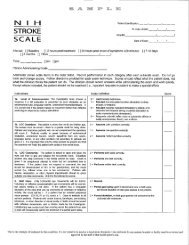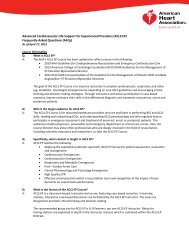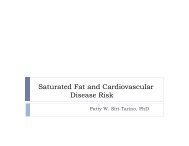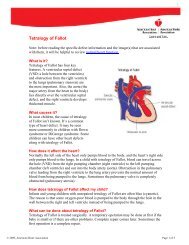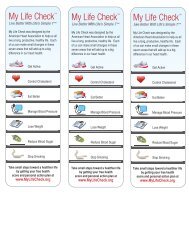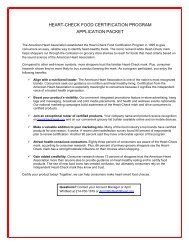Downsizing the Epidemic: Menu Labeling in Restaurants
Downsizing the Epidemic: Menu Labeling in Restaurants
Downsizing the Epidemic: Menu Labeling in Restaurants
Create successful ePaper yourself
Turn your PDF publications into a flip-book with our unique Google optimized e-Paper software.
FACT SHEET: <strong>Menu</strong> <strong>Label<strong>in</strong>g</strong> <strong>in</strong> <strong>Restaurants</strong><br />
least 15 stores to list calories per serv<strong>in</strong>g next to<br />
each food item on <strong>the</strong> menu or menu board. NYC<br />
conducted an accompany<strong>in</strong>g education campaign to<br />
teach consumers about calories and cont<strong>in</strong>ues to<br />
monitor and evaluate <strong>the</strong> program.<br />
It was <strong>in</strong>itiatives like NYC and <strong>in</strong>creas<strong>in</strong>g momentum<br />
for menu label<strong>in</strong>g across <strong>the</strong> country – such as <strong>in</strong><br />
Philadelphia and <strong>the</strong> state of California – that<br />
provided <strong>the</strong> impetus for <strong>the</strong> federal legislation.<br />
Research <strong>in</strong> NYC about <strong>the</strong> impact on consumer<br />
behavior and <strong>in</strong>dustry response has provided<br />
valuable <strong>in</strong>formation. Initial consumer reaction to <strong>the</strong><br />
NYC regulation was very promis<strong>in</strong>g:<br />
• Eighty-six percent of consumers thought it<br />
was a positive move;<br />
• Eighty-four percent said <strong>the</strong>y read <strong>the</strong><br />
calories on menus;<br />
• N<strong>in</strong>ety-seven percent said that calories were<br />
higher than <strong>the</strong>y expected; and<br />
• Seventy-seven percent said that restaurants<br />
have a responsibility to respond to<br />
consumers’ nutritional concerns. 16<br />
However, six months after implementation, one<br />
study found that only 27% of adults and 9% of<br />
adolescents <strong>in</strong> NYC were both read<strong>in</strong>g and<br />
consider<strong>in</strong>g <strong>the</strong> posted nutrition <strong>in</strong>formation when<br />
choos<strong>in</strong>g <strong>the</strong>ir meals. 17,18 Clearly, additional<br />
consumer education will be needed to ensure that<br />
federal menu label<strong>in</strong>g requirements lead to broader<br />
changes <strong>in</strong> consumer behavior.<br />
MAKING IT HAPPEN<br />
Standardiz<strong>in</strong>g calorie <strong>in</strong>formation on menus is easier<br />
for larger fast food cha<strong>in</strong>s, where food preparation<br />
and portion sizes are highly controlled. However,<br />
accurate nutrient composition databases and<br />
software for label<strong>in</strong>g are widely available and it is<br />
easier than ever before for all restaurants to<br />
calculate calorie content <strong>in</strong> menu offer<strong>in</strong>gs. 19 No<br />
matter which restaurant customers choose, <strong>the</strong>y<br />
need and deserve <strong>the</strong> calorie and nutrition<br />
<strong>in</strong>formation.<br />
The ability of customers to customize <strong>in</strong>gredients <strong>in</strong><br />
some of <strong>the</strong>ir meal selections does pose a<br />
challenge. However, for most food items, a close<br />
estimate of calories will provide consumers <strong>the</strong><br />
<strong>in</strong>formation <strong>the</strong>y need to make an <strong>in</strong>formed and<br />
healthy choice.<br />
ACTION PLAN FOR MENU LABELING<br />
The American Heart Association will advocate for:<br />
• Robust and timely implementation of <strong>the</strong><br />
federal menu label<strong>in</strong>g law;<br />
• An accompany<strong>in</strong>g consumer education<br />
campaign to help people understand how<br />
many calories <strong>the</strong>y should eat <strong>in</strong> a day to<br />
achieve or ma<strong>in</strong>ta<strong>in</strong> a healthy weight;<br />
• Monitor and evaluate menu and vend<strong>in</strong>g<br />
mach<strong>in</strong>e label<strong>in</strong>g <strong>in</strong>itiatives; track consumer<br />
purchas<strong>in</strong>g and consumption, <strong>in</strong>dustry<br />
<strong>in</strong>novation, and <strong>the</strong> impact on public health;<br />
and<br />
• Assur<strong>in</strong>g that menu label<strong>in</strong>g at <strong>the</strong> state and<br />
local level that addresses all restaurants not<br />
covered by <strong>the</strong> federal law display calorie<br />
counts on <strong>the</strong>ir menus and menu boards and<br />
offer nutrition <strong>in</strong>formation <strong>in</strong> a manner<br />
consistent with federal law.<br />
References<br />
1 Poti J, Popk<strong>in</strong> B. Trends <strong>in</strong> energy <strong>in</strong>take among US children by eat<strong>in</strong>g<br />
location and food source, 1977-2006. J Am Diet Assoc 2011; 111(8): 1156..<br />
2 Cohen, DA, & Bhatia, R. Nutrition standards for away-from-home foods <strong>in</strong><br />
<strong>the</strong> USA. Obesity Reviews, 2012; 13(7):618-29.<br />
3 Piernas, C., & Popk<strong>in</strong>, BM.. Food portion patterns and trends among US<br />
children and <strong>the</strong> relationship to total eat<strong>in</strong>g occasion size, 1977–2006. The<br />
Journal of Nutrition, 2011; 141(6), 1159-1164.<br />
4 Roberto, C. A., Larsen, P. D., Agnew, H., Baik, J., & Brownell, K. D. (2010).<br />
Evaluat<strong>in</strong>g <strong>the</strong> impact of menu label<strong>in</strong>g on food choices and <strong>in</strong>take. American<br />
Journal of Public Health, 100(2)<br />
5 Girz, L, Polivy, J, Herman, CP, & Lee, H. The effects of calorie <strong>in</strong>formation<br />
on food selection and <strong>in</strong>take. International Journal of Obesity, 2011; 36:<br />
1340–1345<br />
6 Pulos E, Leng K. Evaluation of a voluntary menu-label<strong>in</strong>g program <strong>in</strong> fullservice<br />
restaurants. Am J Public Health. 2010;100:1035-1039.<br />
7 Tandon PS, et al., Nutrition menu label<strong>in</strong>g may lead to lower-calorie<br />
restaurant meal choices for children. Pediatrics. February 2010. 125(2):244-<br />
248.<br />
8 Vadiveloo, MK, Dixon, LB, & Elbel, B. Consumer purchas<strong>in</strong>g patterns <strong>in</strong><br />
response to calorie label<strong>in</strong>g legislation <strong>in</strong> New York City. International<br />
Journal of Behavioral Nutrition and Physical Activity, 2011, 8(1), 51.<br />
9 Fulkerson, JA, et al. Away-from-Home Family D<strong>in</strong>ner Sources and<br />
Associations with Weight Status, Body Composition, and Related Biomarkers<br />
of Chronic Disease among Adolescents and Their Parents. Journal of <strong>the</strong><br />
American Dietetic Association, 2011; 111(12), 1892-1897.<br />
10 Wootan M & Osborn M. Availability of nutrition <strong>in</strong>formation from cha<strong>in</strong><br />
restaurants <strong>in</strong> <strong>the</strong> United States. American Journal of Preventive Medic<strong>in</strong>e.<br />
2006; 30: 266–8.<br />
11 Puhl, R. M., & Heuer, C. A. (2010). Obesity stigma: important<br />
considerations for public health. American journal of public health, 100(6),<br />
1019.<br />
12 Levy, D. Combat<strong>in</strong>g <strong>the</strong> <strong>Epidemic</strong> of Heart DiseaseCombat<strong>in</strong>g <strong>the</strong> <strong>Epidemic</strong><br />
of Heart Disease. JAMA, 2012; 308(24), 2624-2625.<br />
13 Swartz, JJ, Braxton, D, & Viera, AJ. Calorie menu label<strong>in</strong>g on quick-service<br />
restaurant menus: an updated systematic review of <strong>the</strong> literature. International<br />
Journal of Behavioral Nutrition and Physical Activity, 2011; 8(1), 135.<br />
14 Lichtenste<strong>in</strong> AH, et al.. Diet and lifestyle recommendations revision 2006,<br />
Circulation. 2006; 114: 82-96.<br />
15 Rules of <strong>the</strong> City of New York, Title 24, New York City Health Code<br />
x81.50.<br />
16 Technomic, Inc. Executive Summary. Consumer Reaction to Calorie<br />
Disclosure on menus/menu boards <strong>in</strong> New York City. Project Number<br />
13109.September 2008.<br />
17 Dumanovsky, T, Huang, CY, Bassett, MT, & Silver, LD. Consumer<br />
awareness of fast-food calorie <strong>in</strong>formation <strong>in</strong> New York City after<br />
implementation of a menu label<strong>in</strong>g regulation. American Journal of Public<br />
Health, 2010; 100(12), 2520.<br />
18 Elbel, B, Gyamfi, J, & Kersh, R. Child and adolescent fast-food choice and<br />
<strong>the</strong> <strong>in</strong>fluence of calorie label<strong>in</strong>g: a natural experiment. International Journal of<br />
Obesity, 2011; 35(4), 493-500.<br />
19 U.S. Food and Drug Adm<strong>in</strong>istration, Calories Count: Report of <strong>the</strong> Work<strong>in</strong>g<br />
Group on Obesity (July 1, 2009), accessed at:<br />
http://www.fda.gov/Food/<strong>Label<strong>in</strong>g</strong>Nutrition/ReportsResearch/ucm081770.htm<br />
AHA/HPFS/2/2013




